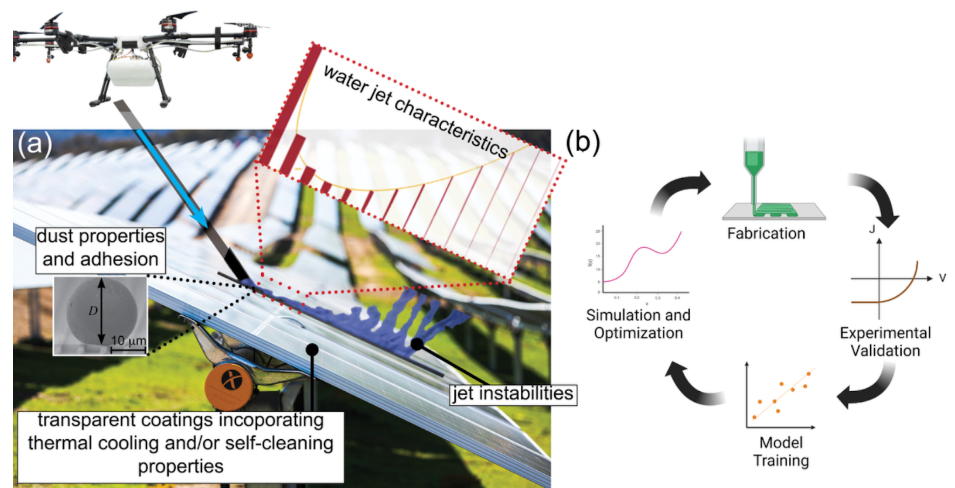The development of large-scale solar infrastructure is critical to a thriving future of humanity that is in harmony with the planet. The center includes these main pillars:
- Research and development, which leverages UC Berkeley’s world-class research facilities and academic expertise to accelerate innovation in solar power plant technology.
- Talent pipeline development of a pool of talented graduates skilled in solar technology, engineering, and sustainability, ready to
contribute to the solar-infrastructure global mission. - Enhancement of academic, industry, and student communities, reinforcing large-scale solar research’s position as critical to powering our planet now and even more so in the future.
To achieve these goals, the center has developed RESEARCH PODS integrating the expertise of faculty at UC Berkeley and
Nextracker engineers:
Research Pod 1: Solar Farm Cleaning & Protective Coatings

Jet impinging on a surface can be used for cleaning and coating of panels: Normal jet impingement of the top side of a horizontal surface and on side of vertical surface in case of hydraulically smooth hydrophilic surfaces is relatively well understood, but for PV surface at any angle and potentially with surface (that may incorporate novel coatings) that can be notably hydrophobic or rough due to coatings or contaminants the situation is poorly understood. This combined with the challenge of diverse nature and level of adhesion of the dirt to be removed, or coatings to be applied, motivates the initial POD 1 study.
Project Coordinators: Jitendra Morankar, Simo Makiharju
UCB Members: Ana Arias, Tom Schuztius, Simo Makiharju, Reza Alam, Tarek Zohdi
Nextracker Members: Harry Van, Bethany Ramadan, Jitendra Morankar
Research Pod 2: Automation, Robotics, Construction, & Asset Management

In this pod, we are interested in the use of robotics and automation technologies for use in constructing, monitoring, and maintaining grid-scale photo-voltaic installations. We consider primarily the use of aerial and legged robotics here.
Our long-term vision is autonomous solar farm construction and management using teams of aerial and legged robots. Aerial robot teams will scan construction sites and legged robots will help assemble and construct the solar panels. Teams of aerial robots will be capable of rapid flight over the solar farm, in close proximity of the panels, to monitor for deviations and problems. For example, one could use these after a large storm to rapidly scan for damages. Where the drones detect possible issues, we envision that individual drones will be able to physically interact with the panels, e.g. spraying them with cleaning liquids to see if the anomaly is dirt or damage. Larger repairs will be done by legged robots.
Project Coordinators: Harry Van, Mark Mueller
UCB Members: Koushil Sreenath, Mark Mueller
Nextracker Members: Harry Van, Bethany Ramadan, Nathan Malone
Research Pod 3: System Monitoring, Power Electronics, Damage, Safety Coordinators
The installation of photovoltaic (PV) power generation sites are expanding at an increasing pace around the world. They possess unique advantages, including the ability to provide local clean power generation and storage, minimizing the need for long power transmission infrastructure. Challenges remain to operate at peak efficiency. For instance, both dust and excessive heat can reduce panel efficiencies. PV installation sites can be affected by natural hazards (wind, flood, hail, wildfire, etc.) as well as experience internal faults that can lead to faults and failures of individual components as well as potentially catastrophic propagating hazards that can lead to larger system failures. PV projects are also restricted due to environmental impacts and require monitoring over time to ensure system performance and compliance with environmental rules and regulations. A critical gap here is the development of monitoring systems to detect faults and inefficiencies as well as to assess system and environmental performance over time.
Project Coordinators: Michael Gollner, Nathan Malone
UCB Members: Michael Gollner, Khalid Mosalam, Ana Arias
Nextracker Members: Nathan Malone, Niloofar Torabi, Wesley Chu